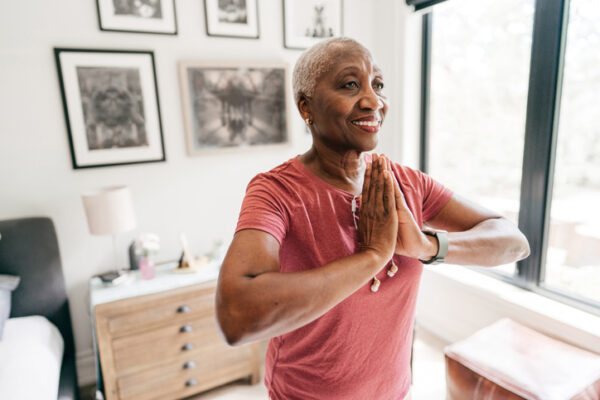
Despite the rising tide of health concerns that can come with age, older adults overwhelmingly agree that they’d prefer to spend their final decades at home, rather than in assisted living facilities.
To make that outcome possible, seniors should start considering their care preferences long before their needs become urgent, and that’s where the involvement of doctors is crucial. By initiating that conversation with healthy older adults and their families, physicians can help preserve their patients’ quality of life — well into the future.
It’s crucial that seniors have the chance to voice their care preferences before they develop health problems that could affect their ability to communicate or make decisions. Involving loved ones in these talks can help prevent the care-related disagreements that can arise during health emergencies, sometimes fracturing families.

As Healthcare and Biopharma Companies Embrace AI, Insurance Underwriters See Risks and Opportunities
In an interview, Munich Re Specialty Senior Vice President Jim Craig talked about the risk that accompanies innovation and the important role that insurers play.
While geriatric specialists are generally comfortable discussing plans for elder care, primary care physicians may find the topic awkward or skip it altogether, concerned that their patients will refuse to engage or even be offended.
Fortunately, some simple strategies can help shift that dynamic. In this article, I’ll provide insights into the benefits of in-home care that will illuminate the advantages of early planning. In addition, I’ll suggest a list of tools doctors can use to make these conversations easier and more rewarding for everyone involved.
The benefits of in-home care
Across the U.S., our senior population is growing more quickly than that of younger adults, and people are living longer than ever before.
This leaves an increasing proportion of Americans responsible for decisions about elder care, highlighting the need for creative solutions.
Traditionally, nursing homes were the go-to choice for older people starting to need help with daily activities, and they can still be great options, as can assisted living facilities for patients with extensive medical needs. Yet, as seniors express a desire to age in place and new technologies are developed to help them succeed, in-home care is becoming a bigger part of the conversation.
For those who can do so safely, there are plenty of reasons to remain at home with some support: continued independence and privacy, maintenance of daily routines that bring comfort and joy, and togetherness with spouses and other family members.
In some cases, at-home care can also be the safer choice, as moving seniors into facilities against their will can cause mental health to deteriorate, despite staff members doing their best to help residents acclimate.
A 2021 study in adults over age 65 found that, compared with older adults living at home, those residing in nursing homes reported lower self-esteem, a higher rate of depression, and more anxiety. In turn, late-life depression can cause cognitive changes, physical symptoms, a general loss of interest, and even an increased chance of death.
But there are other considerations, too; for many families, cost is a deciding factor in mapping out an elder care plan. Unfortunately, there’s no single answer about which setting is the most affordable, which can make the process seem challenging to navigate.
If a senior has health insurance, long-term care insurance, or workplace benefits, this coverage can clarify the most cost-effective path. Also essential to the equation is the extent of care needed. While a nursing home may be more cost-effective for someone who needs 24/7 care, seniors who need less support may find in-home care more affordable.
What does in-home care entail?
In-home care can look very different across households, depending on people’s needs. Caregivers may feed or bathe clients, remind them to take their medications, drive them to doctor’s appointments, prepare their meals, or provide respite care so that family members can have some time off. In-home care organizations can even provide 24-hour service.
Although it was once a foregone conclusion that people with Alzheimer’s or dementia needed to be institutionalized, in-home care is an option for these patients today. With special training, caregivers know how to respond calmly and patiently to people with these conditions, even when their behavior is erratic.
Trained caregivers can even be hired strictly to provide companionship, especially if family members are busy with work or children, live far away, or feel that their caregiving duties are eroding their relationship with the loved one they’re helping. While hiring in-home support for an otherwise healthy senior may sound frivolous, an empathetic trained caregiver can provide a buffer against loneliness, a major problem for older adults that increases the likelihood of dementia and other health issues.
There’s also a correlation between depression and falls in older people, and socialization and positivity can make an enormous difference in helping them avoid these dangers.
As technology advances, it’s becoming even more feasible for seniors to receive care at home, as there are a variety of high-tech devices that can assist them. These include Zoom, FaceTime and other apps for contact with family members and friends; wearable devices that monitor blood pressure, heart rate or cognition and share the information with doctors; shoes that are easy to slip on for people who have trouble bending down; “smart” stoves that shut themselves off when not in use; self-driving vehicles; and even a little robot that can carry a cup of coffee, identify a visitor at the door, alert family members about falls and provide companionship.
These technologies and many more can be an excellent complement to in-home care and can even overlap when trained caregivers help clients use the devices.
A doctor’s toolkit
To ensure that their patients can consider these options before a pressing need arises, primary care physicians must initiate conversations about planning for late-life care.
To make these discussions more comfortable and productive, doctors should:
- Approach the conversation with empathy. Invite family members to attend in person or via Zoom, supply information about both in-home and facility-based care, remind patients to plan for their social well-being as well as their physical health, and leave room for emotions.
- Help families begin their research. Provide links that will shed light on different types of care. Those interested in at-home support should look for credentialed organizations that boast positive testimonials and a commitment to compassion. More support for adults who want to stay at home includes a list of services available to older adults and guidance from The National Council on Aging.
- Share success stories. Relating details about how in-home care has improved quality of life for some of your patients may make others feel more comfortable considering the idea.
- Recommend simple changes now. Low-cost household adjustments can help seniors sustain their independence. Seniors can prevent falls by adding brighter lights, decluttering, removing throw rugs, and installing bathroom grab bars. It can also be helpful to post emergency phone numbers in a central location and check the batteries in smoke and carbon monoxide detectors.
A simple intervention with long-term results
When delivered with a positive and joyful approach, in-home care can have a profoundly protective effect on seniors, with emotional benefits that radiate out to both family members and the trained caregivers assigned to spend time with these clients.
By introducing this option long before it’s needed, primary care doctors can provide a life-changing service to senior patients and their families.
Photo: kate_sept2004, Getty Images
Natalie Black is chief executive officer of Comfort Keepers, North America, which helps seniors thrive safely while living independently at home. She is a passionate and highly intuitive leader with professional experience across the healthcare, financial services, and entertainment industries.
Natalie joined Sodexo in 2015 as director of strategy and franchise business development. Over the next several years, she accepted leadership roles of increasing responsibility, including CFO of Worldwide Home Care and COO of Worldwide Home Care at Sodexo. Natalie earned a B.S. in financial mathematics and statistics from the University of California Santa Barbra and an M.B.A. from Pepperdine Graziadio Business School.
This post appears through the MedCity Influencers program. Anyone can publish their perspective on business and innovation in healthcare on MedCity News through MedCity Influencers. Click here to find out how.









